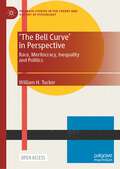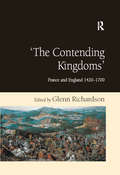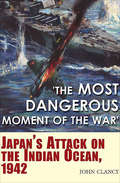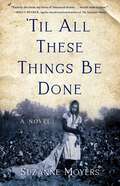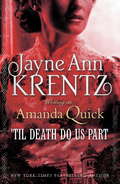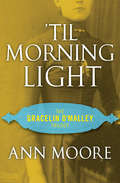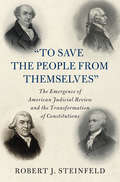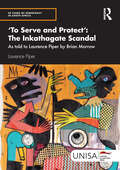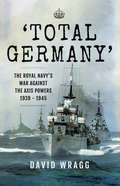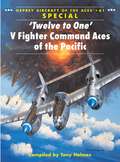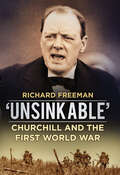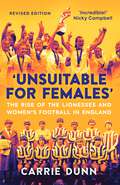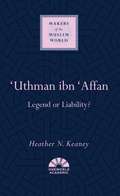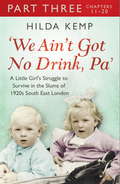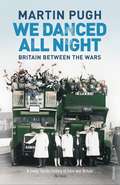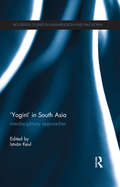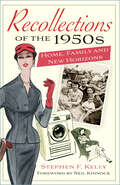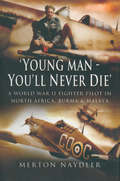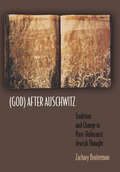- Table View
- List View
'The Bell Curve' in Perspective: Race, Meritocracy, Inequality and Politics (Palgrave Studies in the Theory and History of Psychology)
by William H. TuckerThis open access book examines the implications of The Bell Curve for the social, economic, and political developments of the early 21st century. Following a review of the reception of The Bell Curve and its place in the campaign to end affirmative action, Professor Tucker analyses Herrnstein’s concept of the “meritocracy” in relation to earlier 20th century eugenics and the dramatic increase in economic inequality over the past 30 years. Tucker demonstrates how, contrary to The Bell Curve’s predictions, the reallocation of these huge sums was neither rational nor beneficial for society. The book moves on to situate The Bell Curve within contemporary politics and shows how it can be seen to have played a role in the 2016 US election. This compelling analysis will appeal to scholars and those with an interest in the history of scientific racism, the history of psychology and the sociology of knowledge and science.This is an open access book.
'The Contending Kingdoms': France and England 1420–1700
by Glenn RichardsonThe kingdoms of France and England were for many centuries military, economic, cultural and colonial rivals. This is particularly true of the early modern period which witnessed the rise of French military hegemony and the expansion of English commerce. Dealing with the period 1420-1700, this collection offers a snapshot of Anglo-French relations across the three centuries from established historians and younger scholars from France, Britain and Luxembourg. Based broadly on 'diplomatic' history, but incorporating wider perspectives from cultural and social or gender history; each essay uncovers the fascinating and complex arrangements that characterize Anglo-French relations in this period. Competition and hostility between the two kingdoms there certainly was, but it took a surprising variety of forms and often proved intellectually productive for one side or the other and sometimes for both. The chapters mix treatments of broad themes and particular circumstances or individuals and each makes specific comparisons with French and English experience across the early-modern period. In so doing they elaborate and go beyond the evidence of Anglo-French hostility to explore evidence of political co-operation and cultural influences, highlighting just how close early modern England's connections with France were, even at times of crisis.
'The Damned Fraternitie': Constructing Gypsy Identity in Early Modern England, 1500–1700
by Frances Timbers'The Damned Fraternitie': Constructing Gypsy Identity in Early Modern England, 1500–1700 examines the construction of gypsy identity in England between the early sixteenth century and the end of the seventeenth century. Drawing upon previous historiography, a wealth of printed primary sources (including government documents, pamphlets, rogue literature, and plays), and archival material (quarter sessions and assize cases, parish records and constables's accounts), the book argues that the construction of gypsy identity was part of a wider discourse concerning the increasing vagabond population, and was further informed by the religious reformations and political insecurities of the time. The developing narrative of a fraternity of dangerous vagrants resulted in the gypsy population being designated as a special category of rogues and vagabonds by both the state and popular culture. The alleged Egyptian origin of the group and the practice of fortune-telling by palmistry contributed elements of the exotic, which contributed to the concept of the mysterious alien. However, as this book reveals, a close examination of the first gypsies that are known by name shows that they were more likely Scottish and English vagrants, employing the ambiguous and mysterious reputation of the newly emerging category of gypsy. This challenges the theory that sixteenth-century gypsies were migrants from India and/or early predecessors to the later Roma population, as proposed by nineteenth-century gypsiologists. The book argues that the fluid identity of gypsies, whose origins and ethnicity were (and still are) ambiguous, allowed for the group to become a prime candidate for the 'other', thus a useful tool for reinforcing the parameters of orthodox social behaviour.
'The Most Dangerous Moment of the War': Japan's Attack on the Indian Ocean, 1942
by John Clancy“A well-detailed account of the [World War II] raid, which badly stung the Royal Navy but which the Japanese failed to exploit to a strategic advantage” (Seapower).In early April 1942, a little-known episode of World War II took place. Said by Sir Winston Churchill to be “the most dangerous moment of the war,” the Japanese made their only major offensive westwards into the Indian Ocean. As historian Sir Arthur Bryant said, “A Japanese naval victory in April 1942 would have given Japan total control of the Indian Ocean, isolated the Middle East and brought down the Churchill government.”Having crippled the American fleet at Pearl Harbor, the Japanese turned their sights on the British Eastern Fleet based at Ceylon. Occupation of Ceylon, now Sri Lanka, would not only provide the Japanese a springboard into India but also control of the essential convoy routes to Europe and the Western Desert. And aside from the British Eastern Fleet, the Indian Ocean lay undefended.In April 1942, a Japanese fleet led by six aircraft carriers, four battleships, and thirty other ships sailed into the Bay of Bengal. In the ferocious battles that followed, the British lost a carrier, two heavy cruisers, and many other ships; however, the Japanese eventually turned back, never to sail against India again. John Clancy, whose father survived the sinking of HMS Cornwall during the battle, “masterfully combines the strategic overview, the tactical decision making and many personal experiences to bring this episode of the war to life” (WWII Today).“Absolutely enthralling.” —Books Monthly“Well researched . . . a balanced view of men acting under the stress of war during a critical time.” —WWII History
'Til All These Things Be Done: A Novel
by Suzanne MoyersSet against the rich but often troubled history of Blacklands, Texas, during an era of pandemic, scientific discovery, and social upheaval, the novel offers a unique—yet eerily familiar—backdrop to a universal tale of triumphing over loss. Even as dementia clouds other memories, eighty-three-year-old Leola can’t forget her father’s disappearance when she was sixteen. Now, as Papa appears in haunting visions, Leola relives the circumstances of that loss: the terrible accident that steals Papa’s livelihood, sending the family deeper into poverty; a scandal from Mama’s past that still wounds; and Leola’s growing unease with her brutally bigoted society. When Papa vanishes while seeking work in Houston and Mama dies in the “boomerang” Influenza outbreak of 1919, Leola and her young sisters are sent to an orphanage, where her exposure of a dark injustice means sacrificing a vital clue to Papa’s whereabouts. That decision echoes into the future, as new details about his disappearance suggest betrayal too painful to contemplate. Only in old age, as her visions of Papa grow more realistic, does Leola confront her long-buried grief, leading to a remarkable family discovery that could offer peace, at last.
'Til Death Do Us Part
by Amanda QuickCalista Langley operates an exclusive 'introduction' agency in Victorian London, catering to respectable ladies and gentlemen who find themselves alone in the world. But now, a dangerously obsessed individual has begun sending her trinkets and gifts suitable only for those in deepest mourning - a black mirror, a funeral wreath, a ring set with black jet stone. Each is engraved with her initials.Desperate for help and fearing that the police will be of no assistance, Calista turns to Trent Hastings, a reclusive author of popular crime novels. Believing that Calista may be taking advantage of his lonely sister, who has become one of her clients, Trent doesn't trust her. Scarred by his past, he's learned to keep his emotions at bay, even as an instant attraction threatens his resolve.But as Trent and Calista comb through files of rejected clients in hopes of identifying her tormentor, it becomes clear that the danger may be coming from Calista's own secret past - and that only her death will satisfy the stalker...
'Til Morning Light (The Gracelin O'Malley Trilogy #3)
by Ann MooreAn Irish mother faces her destiny in California as the acclaimed trilogy comes to an end—&“a vibrant picture of American history in the mid-19th century&” (Historical Novel Society). With her two children, Gracelin O&’Malley travels to post–Gold Rush San Francisco to meet the sea captain who has proposed marriage to her. But when she arrives, he is nowhere to be found. Destitute in a city filled with gangs, disillusioned soldiers, and professional gamblers, Grace takes a position as a cook for one of the city&’s most prominent doctors—only to become caught up in a tangled web of blackmail and betrayal. Determined to make a secure life for her children and find her brother, Sean, Gracelin sets in motion a series of events that change the future of everyone around her, never dreaming that the man she thought she&’d lost forever is still alive and determined to find his way back to her. Dickensian in scope, with a full cast of riveting characters, Ann Moore&’s &’Til Morning Light is the stunning conclusion to the enthralling story of Gracelin O&’Malley, a heroine for the ages.
'To Save the People from Themselves': The Emergence of American Judicial Review and the Transformation of Constitutions (Cambridge Historical Studies in American Law and Society)
by Robert J. SteinfeldIn this expansive history, Robert J. Steinfeld offers a thorough re-interpretation of the origins of American judicial review and the central role it quickly came to play in the American constitutional system. Beginning with Privy Council review of American colonial legislation, the book goes on to provide detailed descriptions of the character of the first American constitutions, showing that they drew heavily on traditional Anglo/American constitutional assumptions, which treated legislatures as the primary interpreters of constitutions. Steinfeld then expertly analyses the central role lawyers and judges played in transforming these assumptions, creating the practice and doctrine of American judicial review in a half dozen state cases during the 1780s. The book concludes by showing that the ideas formulated during those years shaped critical decisions taken by the Constitutional Convention of 1787, which turned the novel practice into a permanent, if still deeply controversial, feature of the American constitutional system.
'To Serve and Protect': As told to Laurence Piper by Brian Morrow (30 Years of Democracy in South Africa)
by Laurence PiperThis book provides a detailed account of the history, consequences, and events leading up to the ‘Inkathagate Scandal’ which changed the course of South African history. It states that Inkathagate was the work of one man – Brian Morrow – who outraged by the racism, corruption and torture rife in the Security Branch of the South African Police in Durban where he worked, resolved to do something to expose the reality of apartheid hidden from white South Africa and the world. It also discusses the Inkatha files, which Morrow had covertly copied and handed to the media in 1991, and also analyses Morrow’s purpose, ambitions, and what followed after.Print editions not for sale in Sub-Saharan Africa. This book is part of Routledge’s co-published series 30 Years of Democracy in South Africa, in collaboration with UNISA Press, which reflects on the past years of a democratic South Africa and assesses the future opportunities and challenges.
'Total Germany': The Royal Navy's War Against the Axis Powers 1939–1945
by David WraggThe author of A Century of British Naval Aviation, 1909-2009 examines the losses and successes of the Royal Navy during World War Two. On the declaration of war in 1939, the British Admiralty signaled all warships and naval bases &“Total Germany, Total Germany.&” It was fortunate that of Germany&’s three armed services, the Kriegsmarine under Grosseradmiral Erich Raeder was the least well prepared. True, Admiral Karl Donitz&’s U-Boat force was to give the Allies many anxious times, but Hitler was never comfortable or competent in his handling of naval surface forces. &“Total Germany&” is a concise yet comprehensive account of the Royal Navy&’s part in the war at sea and the measures taken to ensure victory. The different approaches taken by the warring countries are expertly examined. The author reviews the differing strategies and tactics of the various theatres such as the Far East, Mediterranean, Atlantic and Arctic. &“Not only does it cover every major event during WWII the author brings up some other less well known actions. A thoroughly enjoyable read.&”—Ton Class Association
'Twas the Night After Christmas (The Hellions of Halstead Hall #6)
by Sabrina JeffriesNew York Times bestselling author Sabrina Jeffries&’s &“exceptionally entertaining&” (Booklist) Hellions of Halstead Hall series offers a charming gift of a romance about an unexpected Christmas reunion that&’s sparked by a clever ruse.Pierce Waverly, the Earl of Devonmont, has never forgiven his parents for inexplicably abandoning him to distant relatives as a child. Nevertheless, when he receives word that the stranger he calls &“Mother&” is gravely ill, the unabashed rogue makes a rare return to Montcliff, his country estate. There he finds that the woman is perfectly healthy—and that he has fallen for a cunning ruse crafted by her lady&’s companion, Mrs. Camilla Stuart. The lively vicar&’s widow, too bright and beautiful not to arouse the scoundrel in Pierce, is determined to reconcile the Earl and Lady Devonmont. None of them can predict the secrets, both heartening and shocking, divulged between a mother and son, or between two lovers, each haunted by their pasts, that will make this Christmas night at Montcliff one to remember—and the glorious night after, one to treasure for a lifetime in this &“sharply witty, deliciously sexy&” (Library Journal) romance.
'Twelve to One' V Fighter Command Aces of the Pacific
by Tony Holmes Chris DaveyThis volume details the experiences of 107 elite American aces in combat against the Japanese. The highest scoring US pilots of World War 2 fought against the Japanese Army Air Force and Imperial Japanese Navy over the jungles of New Guinea and the Philippines. Flying P-38s and P-47s, men such as Dick Bong and Thomas McGuire won the Medal of Honor for their successes in combat in 1943-45. 'Twelve to One' is a rare document that details the 'tricks of the trade' employed by these men. This volume also includes biographies of the men whose tips for aerial combat make up the text, and the V Fighter Command Manual.
'Union is Strength'
by Albert SchrauwersNineteenth-century Canada experienced two other revolutions apart from those of W.L. Mackenzie and Louis Riel: the transition to capitalism, and to responsible government. Union Is Strength argues that these major socio-political changes happened in Ontario without a revolutionary moment because of the intertwined relationship of reformers with capitalists. Examining a small, utopian socialist group named the Children of Peace, Albert Schrauwers traces the emergence of a vibrant democratic culture in the province from the decade before the Rebellions of 1837. Schrauwers shows how the overlapping boards of unincorporated joint stock companies managed by both Toronto reformers and the Children of Peace produced a culture of deliberative democracy in competition with the "gentlemanly capitalism" of chartered corporations. Noting the ways in which Ontario's capitalist and democratic revolutions were linked through cooperative joint stock operations, he also situates these revolutions in an international context and links them to the development of Owenite socialism and Chartism in the United Kingdom. Union Is Strength is an insightful study of both nineteenth century Canada and the ways in which regional political cultures arise.
'Unsinkable': Churchill and the First World War
by Richard Freeman‘Unsinkable’ is the story of a man unjustly vilified: Churchill in the First World. His enemies – the Tory party – censured him for Antwerp, the Dardanelles and Gallipoli. He could do no right and was regarded as a dangerous maniac. But the true story is quite the opposite. This book tells how, as a brilliant First Sea Lord, Churchill was ousted by his enemies, yet clawed his way back to power against all the odds. As the leading critic of senselessly sending men to march towards machine guns his calls for ‘machines not men’ went unheeded. After a spell in the trenches he returned to London to clear his name over the Dardanelles. Then he relentless fought his way back to power through his brilliant, incisive criticism of the land war. The unsinkable politician finally became Munitions Minster in 1917, where he pushed output to unimagined levels. His weapons delivered the victory that had eluded others for the previous three years.
'Unsuitable for Females': The Rise of the Lionesses and Women's Football in England
by Carrie DunnShortlisted for the 2023 Sports Book Awards for Best Football Writing of the Year Discover the origins of the Lionesses that brought football home. England's Lionesses are on the front and back pages; their stars feature on prime-time television; they are named in the national honours lists for their contribution to their sport and to society. The names of Lucy Bronze, Steph Houghton and Ellen White are emblazoned across the backs of children’s replica jerseys. These women are top athletes – and top celebrities. But in 1921, the Football Association introduced a ban on women’s football, pronouncing the sport 'quite unsuitable for females'. That ban would last for half a century - but despite official prohibition the women’s game went underground. From the Dick, Kerr Ladies touring the world to the Lost Lionesses who played at the unsanctioned Women's World Cup in Mexico in 1971, generations of women defied the restrictions and laid the foundations for today's Lionesses - so much so that in 2018 England's Women’s Super League became the first fully professional league in Europe...when just a few decades previously women were forbidden to play the sport in England at all. This book tells the story of women’s football in England since its 19th-century inception through pen portraits of its trailblazers. The game might have once been banned because of its popularity – find out about the subversive women who kept organising their teams and matches despite the prohibition, who broke barriers and set records – the legends of the game who built the foundations of the stage upon which today’s stars flourish. 'At what feels like a pivotal moment, Carrie’s forensic research and depth of knowledge make her the perfect person to guide us through the constantly changing landscape of women’s football' - Kelly Cates, TV presenter
'Uthman ibn 'Affan: Legend or Liability? (Makers of the Muslim World)
by Heather N. Keaney&‘Uthman ibn &‘Affan (d. 656) was an early convert to Islam and the third successor to the Prophet Muhammad. As caliph he established the first Islamic navy, consolidated the text of the Qur&’an, and expanded the Arab empire. His opponents, however, accused him of being corrupt and questioned his legitimacy. After twelve years &‘Uthman&’s troubled caliphate ended in revolt. His death at the hands of rebels led to civil war and contributed to the eventual split between Sunni and Shi&’i Islam. In this volume, Heather Keaney examines the life and legacy of the controversial caliph.
'We Ain't Got No Drink, Pa': Part 3
by Cathryn Kemp Hilda KempWe Ain't Got No Drink, Pa can either be read as full-length eBook or in 3 serialised eBook-only parts.This is PART 3 OF 3.'We ain't got no drink, Pa.' I trembled as I spoke. Then somewhere inside me I found the anger, the courage to answer him back. 'We don't have no grog cos you drank it all!' I knew he was going for me tonight, so I reckoned I might as well go down fighting after all. Growing up in the slums of 1920s and 30s Bermondsey, Hilda Kemp's childhood was one of chaos and fear. Every day was battleground, a fight to survive and a fight to be safe. For Hilda knew what it was to grow up in desperate poverty: to have to scratch around for a penny to buy bread; to feel the seeping cold of a foggy docklands night with only a thin blanket to cover her; to share her filthy mattress with her brothers and sisters, fighting for space while huddling to keep warm. She knew what it was to feel hunger - not the impatient growl of a tummy that has missed a meal; proper hunger, the type that aches in your soul as much as your belly. The eldest of five children, Hilda was the daughter of a hard drinker and hard hitter as well. A casual dockworker by day, a bare-knuckle fighter by night and a lousy drunk to boot, her pa honed his fists down the Old Kent Road and Blackfriars, and it was Hilda or her ma who bore the brunt of them at home. This is the powerful and moving memoir of Hilda's childhood growing up in dark, filthy, crime-ridden Bermondsey; a place where you knew your neighbours, where you kept your eyes down and your ears shut as defence against the gangs at war in the streets. It's a time when days were spent running wild down the docklands, jumping onto barges and stealing coal, racing through the dank back-streets of east London like water rats, dodging the milk cart or the rag-and-bone man. And out of this bleak landscape emerges a brave, resilient young girl whose life is a testament to the power of love and good humour. Moving, dazzling and sombre by turns, once opened this brilliant, seductive book will not let you rest.
'We Danced All Night': A Social History of Britain Between the Wars
by Martin PughMartin Pugh offers a uniquely untraditional view of Britain’s inter-war period; that among the many dramatic social changes taking place, our modern consumer society of dedicated shoppers effectively took shape during the 1930s.
'Yogini' in South Asia: Interdisciplinary Approaches
by István KeulIn different stages in the history of South Asian religions, the term yoginī has been used in various contexts to designate various things: a female adept of yoga, a female tantric practitioner, a sorceress, a woman dedicated to a deity, or a certain category of female deities. This book brings together recent interdisciplinary perspectives on the medieval South Asian cults of the Yoginis, such as textual-philological, historical, art historical, indological, anthropological, ritual and terminological. The book discusses the medieval yoginī cult, as illustrated in early Śaiva tantric texts, and their representations in South Asian temple iconography. It looks at the roles and hypostases of yoginīs in contemporary religious traditions, as well as the transformations of yoginī-related ritual practices. In addition, this book systematizes the multiple meanings, and proposes definitions of the concept and models for integrating the semantic fields of ‘yoginī.’ Highlighting the importance of research from complementary disciplines for the exploration of complex themes in South Asian studies, this book is of interest to scholars of South Asian Studies and Religious Studies.
'You've Never Had It So Good!': Memories and Recollections of Life in the 1950s
by Stephen F Kelly Neil KinnockThe 1950s saw a major shift in the lifestyles of many in Britain. The austerity that had dogged the 1940s after the end of the Second World War began to give way to better times. Employment levels rose to new heights, white consumer goods appeared in shop windows for the first time, television replaced the radio in most homes, rock and roll was born, the National Health Service provided free health care to the nation, more children went to grammar schools, leisure time increased, families went on holiday, and the new Queen was crowned — bringing in a glorious new Elizabethan age.Including interviews with former Labour leader Lord Neil Kinnock, footballers Bobby Charlton, Wilf McGuinness and Terry Venables, radio producer, author and journalist Clare Jenkins, and the eminent historian Lord Peter Hennessy, among others, this delightful compendium of reminiscences will appeal to all who grew up in this post-war decade, whether in town or country, wealth or poverty. With chapters on schooldays, TV and radio, trips to the seaside, music and fashion, these wonderful stories are sure to jog the memories of all who remember this exciting era.
'Young Man, You'll Never Die': A World War II Fighter Pilot In North Africa, Burma & Malaya (Reminiscence Ser.)
by Merton NaydlerA British Royal Air Force pilot recounts fighting over African deserts and Asian jungles during World War II in this military memoir. Merton Naydler joined the RAF at the age of nineteen and served for the next six years until May 1946. He flew Spitfires and Hurricanes during a tour of duty that took him to North Africa, Burma, and Malaya. This well written and extremely entertaining memoir portrays wartime life in the desert environment where sand, flies, life under canvas made living and flying a daunting experience. When Naydler was posted to Burma he was filled with &“a deep and genuine dread.&” After a long uncomfortable trip, he joined 11 Squadron and was then faced with Japanese Zeroes in combat over dense tropical jungle rather than Bf 109s over a barren desert terrain. &“Daytime flying was hot as hell, the humidity intense&”—the author&’s description of his new posting that goes on to describe life in &“Death Valley,&” named because of the likeliness of falling victim to tropical disease rather than enemy aircraft . . . This is the story of a sergeant pilot who learned his trade the hard way in action over Africa and then honed his combat skills in the skies over Japanese-held tropical forests where he was eventually commissioned.
'n Kristal Engel
by Dawn Brower’n Dronk belofte van verlowing het Thor se familie teen hom gedraai. Sal Thor Pia se vergifnis verdien en hulle weghardlopende kinders betyds vir Kersfees vind? Na 'n nag van kaarte en drinkery, was Thor se skeurende hoofpyn die minste van sy bekommernisse. Wanneer 'n boodskapper opdaag met 'n kontrak vir hom om te teken, ontdek sy vrou Pia hy het ingestem om hulle seun aan die graaf van Devon se dogter te verloof. Pia is verby woedend en eis dat hy dit regmaak—of anders. Nadat hulle die argument tussen hulle ouers gehoor het, besluit die tweeling Liam en Lily om weg te hardloop uit protes teen die kontrak. Thor en Pia gaan op soek na hulle opstandige kinders voordat iets verskrikliks met hulle gebeur. Sal Thor Pia oortuig om hom te vergewe en die tweeling voor Kersfees te vind, of sal hulle gesin vir altyd uitmekaar val?
(God) After Auschwitz: Tradition and Change in Post-Holocaust Jewish Thought
by Zachary BraitermanThe impact of technology-enhanced mass death in the twentieth century, argues Zachary Braiterman, has profoundly affected the future shape of religious thought. In his provocative book, the author shows how key Jewish theologians faced the memory of Auschwitz by rejecting traditional theodicy, abandoning any attempt to justify and vindicate the relationship between God and catastrophic suffering. The author terms this rejection "Antitheodicy," the refusal to accept that relationship. It finds voice in the writings of three particular theologians: Richard Rubenstein, Eliezer Berkovits, and Emil Fackenheim. This book is the first to bring postmodern philosophical and literary approaches into conversation with post-Holocaust Jewish thought. Drawing on the work of Mieke Bal, Harold Bloom, Jacques Derrida, Umberto Eco, Michel Foucault, and others, Braiterman assesses how Jewish intellectuals reinterpret Bible and Midrash to re-create religious thought for the age after Auschwitz. In this process, he provides a model for reconstructing Jewish life and philosophy in the wake of the Holocaust. His work contributes to the postmodern turn in contemporary Jewish studies and today's creative theology.
(North Carolina) American Anthem
by Edward L. Ayers Robert D. Schulzinger Jesús F. de la Teja Deborah Gray WhiteNIMAC-sourced textbook
(Not Quite) Mastering the Art of French Living
by Mark GreensideEvery year upon arriving in Plobien, the small Breton town where he spends his summers, American writer Mark Greenside picks back up where he left off with his faux-pas–filled Francophile life. Mellowed and humbled, but not daunted (OK, slightly daunted), he faces imminent concerns: What does he cook for a French person? Who has the right-of-way when entering or exiting a roundabout? Where does he pay for a parking ticket? And most dauntingly of all, when can he touch the tomatoes? Despite the two decades that have passed since Greenside’s snap decision to buy a house in Brittany and begin a bi-continental life, the quirks of French living still manage to confound him. Continuing the journey begun in his 2009 memoir about beginning life in France, (Not Quite) Mastering the Art of French Living details Greenside’s daily adventures in his adopted French home, where the simplest tasks are never straightforward but always end in a great story. Through some hits and lots of misses, he learns the rules of engagement, how he gets what he needs—which is not necessarily what he thinks he wants—and how to be grateful and thankful when (especially when) he fails, which is more often than he can believe. Introducing the English-speaking world to the region of Brittany in the tradition of Peter Mayle’s homage to Provence, Mark Greenside’s first book, I’ll Never Be French, continues to be among the bestselling books about the region today. Experienced Francophiles and armchair travelers alike will delight in this new chapter exploring the practical and philosophical questions of French life, vividly brought to life by Greenside’s humor and affection for his community.
